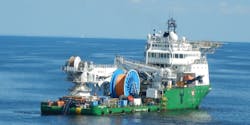Study highlights possible emissions reductions with thermoplastic composite pipe
OSLO, Norway – DNV, Strohm, and the Non-Metallic Innovation Centre (NIC) have issued a report comparing the carbon footprints of externally coated carbon steel pipe and thermoplastic composite pipes (TCP).
Findings suggest that TCP’s carbon footprint could be 30-60% lower than an equivalent carbon steel pipeline solution.
The authors took into account all steps of the lifecycle carbon footprint. This included direct and indirect greenhouse gas (GHG) emissions associated with all activities in the product’s life cycle, from material extraction and production to the pipelines’ end-of-life stage.
The report also outlined results from a joint industry project between DNV, Strohm, and NIC, focusing on the lifecycle of a 22-km (13.7-mi) subsea pipeline delivering produced water for injection into a field offshore Angola, with an operating lifespan of 20 years.
Prajeev Rasiah, Executive Vice President for Energy Systems, Northern Europe at DNV said that the study highlighted the importance of efficient transport logistics and installation, including the impact of vessels on the total carbon footprint for both steel and TCP. “While admittedly limited to certain geographies and scenarios, the current case study has shown that TCP has an advantage within this area,” Rasiah said.
Caroline Justet, business growth executive for energy in transition at Strohm, said: “The greatest GHG benefits from using TCP compared to steel will be in the cases when the pipe needs to be transported over long distances. “TCP is spoolable and lightweight, allowing it to be delivered in long lengths and installed using small vessels or subsea pallets, significantly reducing CO2 emissions,” Justet said.
3/7/2022
